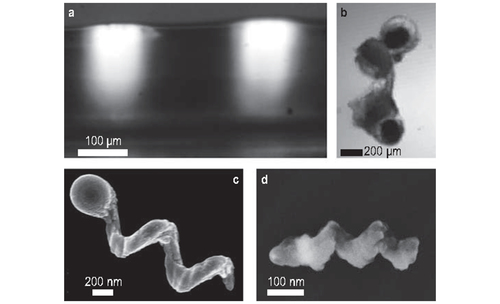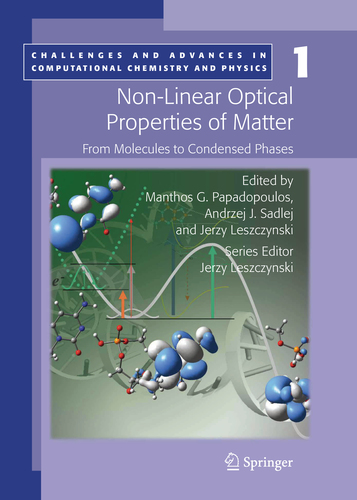5 results
(View BibTeX file of all listed publications)
2022
Magnetic Micro-/Nanopropellers for Biomedicine
Qiu, T., Jeong, M., Goyal, R., Kadiri, V., Sachs, J., Fischer, P.
In Field-Driven Micro and Nanorobots for Biology and Medicine, pages: 389-410, 16, (Editors: Sun, Y. and Wang, X. and Yu, J.), Springer, Cham, 2022 (inbook)
In nature, many bacteria swim by rotating their helical flagella. A particularly promising class of artificial micro- and nano-robots mimic this propeller-like propulsion mechanism to move through fluids and tissues for applications in minimally-invasive medicine. Several fundamental challenges have to be overcome in order to build micro-machines that move similar to bacteria for in vivo applications. Here, we review recent advances of magnetically-powered micro-/nano-propellers. Four important aspects of the propellers – the geometrical shape, the fabrication method, the generation of magnetic fields for actuation, and the choice of biocompatible magnetic materials – are highlighted. First, the fundamental requirements are elucidated that arise due to hydrodynamics at low Reynolds (Re) number. We discuss the role that the propellers’ shape and symmetry play in realizing effective propulsion at low Re. Second, the additive nano-fabrication method Glancing Angle Deposition is discussed as a versatile technique to quickly grow large numbers of designer nano-helices. Third, systems to generate rotating magnetic fields via permanent magnets or electromagnetic coils are presented. And finally, the biocompatibility of the magnetic materials is discussed. Iron-platinum is highlighted due to its biocompatibility and its superior magnetic properties, which is promising for targeted delivery, minimally-invasive magnetic nano-devices and biomedical applications.
2020
Soft Microrobots Based on Photoresponsive Materials
In Mechanically Responsive Materials for Soft Robotics, pages: 327-362, (Editors: Koshima, Hideko), Wiley-VCH, Weinheim, 2020 (incollection)
2018
Nanoscale robotic agents in biological fluids and tissues
Palagi, S., Walker, D. Q. T., Fischer, P.
In The Encyclopedia of Medical Robotics, 2, pages: 19-42, 2, (Editors: Desai, J. P. and Ferreira, A.), World Scientific, October 2018 (inbook)
Nanorobots are untethered structures of sub-micron size that can be controlled in a non-trivial way. Such nanoscale robotic agents are envisioned to revolutionize medicine by enabling minimally invasive diagnostic and therapeutic procedures. To be useful, nanorobots must be operated in complex biological fluids and tissues, which are often difficult to penetrate. In this chapter, we first discuss potential medical applications of motile nanorobots. We briefly present the challenges related to swimming at such small scales and we survey the rheological properties of some biological fluids and tissues. We then review recent experimental results in the development of nanorobots and in particular their design, fabrication, actuation, and propulsion in complex biological fluids and tissues. Recent work shows that their nanoscale dimension is a clear asset for operation in biological tissues, since many biological tissues consist of networks of macromolecules that prevent the passage of larger micron-scale structures, but contain dynamic pores through which nanorobots can move.
2017
Chapter 8 - Micro- and nanorobots in Newtonian and biological viscoelastic fluids
Palagi, S., (Walker) Schamel, D., Qiu, T., Fischer, P.
In Microbiorobotics, pages: 133 - 162, 8, Micro and Nano Technologies, Second edition, Elsevier, Boston, March 2017 (incollection)
Swimming microorganisms are a source of inspiration for small scale robots that are intended to operate in fluidic environments including complex biomedical fluids. Nature has devised swimming strategies that are effective at small scales and at low Reynolds number. These include the rotary corkscrew motion that, for instance, propels a flagellated bacterial cell, as well as the asymmetric beat of appendages that sperm cells or ciliated protozoa use to move through fluids. These mechanisms can overcome the reciprocity that governs the hydrodynamics at small scale. The complex molecular structure of biologically important fluids presents an additional challenge for the effective propulsion of microrobots. In this chapter it is shown how physical and chemical approaches are essential in realizing engineered abiotic micro- and nanorobots that can move in biomedically important environments. Interestingly, we also describe a microswimmer that is effective in biological viscoelastic fluids that does not have a natural analogue.
2006
NONLINEAR OPTICAL PROPERTIES OF CHIRAL LIQUIDS Electric-dipolar pseudoscalars in nonlinear optics
Fischer, P., Champagne, B.
In NON-LINEAR OPTICAL PROPERTIES OF MATTER: FROM MOLECULES TO CONDENSED PHASES, 1, pages: 359-381, Challenges and Advances in Computational Chemistry and Physics, 2006 (incollection)
We give all overview of linear and nonlinear optical processes that can be specific to chiral molecules in isotropic media. Specifically, we discuss the pseudoscalars that underlie nonlinear optical activity and chiral frequency conversion processes in fluids. We show that nonlinear optical techniques open entirely new ways of exploring chirality: Sum-frequency-generation (SFG) at second-order and BioCARS at fourth-order arise in the electric-dipole approximation and do not require circularly polarized light to detect chiral molecules in solution. Here the frequency conversion in itself is a measure of chirality. This is in contrast to natural optical activity phenomena which are based on the interference of radiation from induced oscillating electric and magnetic dipoles, and which are observed as a differential response to right and left circularly polarized light. We give examples from our SFG experiments in optically active solutions and show how the application of an additional static electric field to sum-frequency generation allows the absolute configuration of the chiral solute to be determined via all electric-dipolar process. Results from ab initio calculations of the SFG pseudoscalar are presented for a number of chiral molecules





